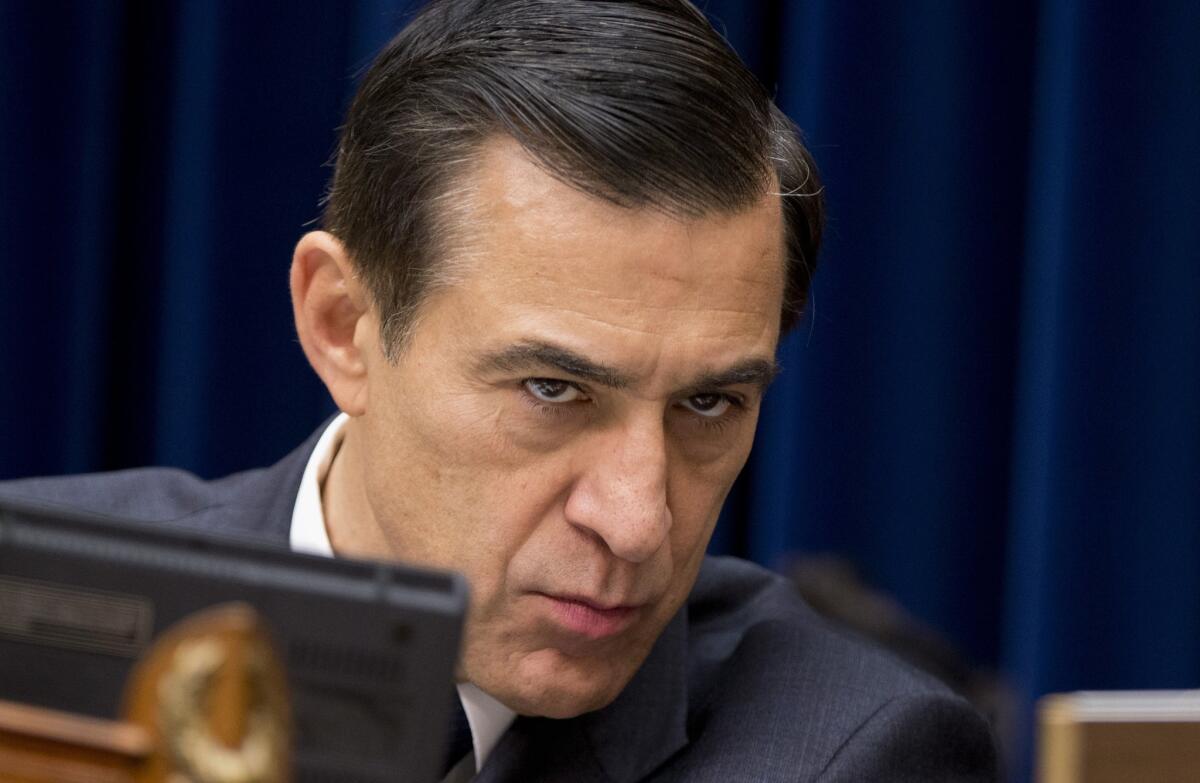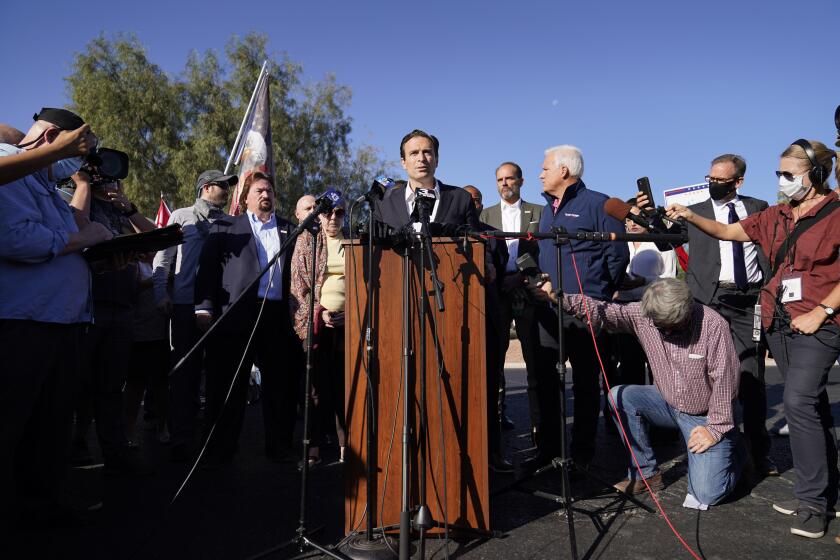The race that is sending Darrell Issa back to Congress carries lessons for California

California Republican Darrell Issa has won his bid to return to Congress, this time representing the 50th congressional district. The former nine-term congressman and ardent supporter of President Trump edged out Democrat Ammar Campa-Najjar, a college lecturer and businessman who ran unsuccessfully for the seat once before.
It was a close race. On election day, Campa-Najjar led initially, but Issa pulled ahead as the night wore on. By Saturday’s count update, Issa had 53.7% of the vote compared with Campa-Najjar’s 46.3%, a 23,470-vote difference.
Issa declared victory on social media Friday night.
“Whether you supported me in this election or not, I will work tirelessly in Congress for all who call the 50th District their home, for the state of California, which I love so much, and for our great country,” Issa wrote. He thanked Campa-Najjar “for a spirited campaign.”
In a statement Saturday night, Campa-Najjar congratulated Issa for a “hard-fought” campaign, which he said included attacks on his Mexican American and Palestinian American heritage. Campa-Najjar said it’s important that he got more votes in the district than President-elect Joe Biden did, thanks to crossover voters.
“I’m incredibly proud of how this campaign left no one out, took no one for granted and brought this community closer together,” Campa-Najjar said.
The race for the 50th District was the highest profile congressional race in the San Diego area this election cycle, spurred by intrigue about who would replace disgraced former Rep. Duncan D. Hunter, who left the seat empty in January after pleading guilty to conspiring to misspend campaign funds.
Political observers say this case was unusual because, although Issa was favored to win, Campa-Najjar stayed close in the polls, sometimes neck and neck.
Michelle Steel’s win hands back to Republicans one of several seats lost in 2018 when Democrats made big gains in Orange County and other red-leaning areas.
“This race broke some of the modern rules of politics,” said Thad Kousser, chair of the political science department at UC San Diego.
Issa had been the favorite since entering the race in September 2019, buoyed by his name recognition for representing parts of San Diego in Congress from 2000 to 2018. He once headed the powerful House Oversight and Government Reform Committee and launched high-profile investigations of the Obama administration.
It was shocking to see the race so close, Kousser said.
“You have an election where Donald Trump brought strong Republican turnout,” he said. “You had a well-known and well-funded candidate free of major scandal, and yet you are still seeing a close contest in one of California’s reddest districts.”
The 50th District — which includes East San Diego, north inland San Diego County and southern Riverside — has long been a Republican stronghold. Before Hunter came under federal indictment, the Alpine Republican won most of his contests by double digits, including a 27-percentage-point win in 2016 and a 42-point win in 2014.
In contrast, Issa this year won by only 7 points.
Campa-Najjar, who ran against Hunter and lost, had never held public office, Kousser noted, adding that it appears some voters crossed party lines and voted split tickets.
“We maintained our base and won crossover Trump voters,” Campa-Najjar said Saturday.
Without exit polling, it’s difficult to determine exactly why the race for the 50th turned out the way it did. However, there were several factors that altered the shape of the race.
Millions of dollars poured into the race on both sides, according to financial reports filed with the Federal Elections Commission in October.
Campa-Najjar raised more than $5.3 million over the election cycle — most of which he used during the general election because he had a lock on one of the primary spots.
Massive vote fraud? No. Nevada is sending one possible case to investigators as Republicans come up mostly empty in attempt to undermine Biden’s win.
His was still far short of Issa’s fundraising haul.
Issa, once the wealthiest member of Congress, contributed more than $7.7 million to his campaign, which helped him raise a total of more than $12 million in the election cycle. He spent much more of his campaign war chest during the primary than Campa-Najjar did because Issa had significant Republican challengers, including talk show host Carl DeMaio.
Jack Pitney, professor of political science at Claremont McKenna College, said a lot of big Democratic donors — instead of giving to candidates in competitive races — chose to invest in contests where their candidate had slim chances. He pointed to the tens of millions spent to challenge Senate Majority Leader Mitch McConnell and South Carolina Sen. Lindsey Graham, both of whom comfortably won reelection.
Some of those millions could have helped candidates such as Campa-Najjar, he said.
“Campaign money isn’t the end-all be-all, but it matters at the margins and the margins matter,” Pitney said. “This was a race where it was close, and it could have potentially made a difference.”
Campa-Najjar said Issa’s fundraising advantage was a factor in the outcome of the 50th race, noting he spent $5 million and Issa spent $8 million on media.
Another factor looming over the race — and, some argue, influencing its ultimate outcome — was President Trump.
Trump became a dominant theme of the Republican side of the race early on. During the primary, Issa and DeMaio mostly fixated on who was the best, most loyal Trump ally.
For the general election, Issa put out mailers touting his relationship with Trump and used Trump’s voice on TV ads and robocalls supporting Issa and attacking Campa-Najjar. Trump also tweeted negatively about Campa-Najjar and favorably about Issa.
Issa was an early backer of Trump in 2016 and was originally tapped to join his administration in December 2018, although the nomination stalled in the Senate.
Tying oneself to Trump can be a perilous thing in California, experts said, as he is largely disliked in much of the state and has contributed to losses for elected officials up and down the ballot in California. In San Diego this week, an incumbent county supervisor, Kristin Gaspar, is 17 points behind a Democratic challenger after trumpeting her ties to the president.
For Issa, though, Trump ties proved part of a winning formula.
“This is a state where the Trump brand is incredibly damaging, especially on the coast, but the more you move inland, the more tying yourself to the president is a huge net positive,” Kousser said. “Issa couldn’t run away [from Trump], so he decided to double down, and it seems like the correct bet.”
Campa-Najjar, who rarely mentioned Trump in his campaign, said in an interview Friday that Trump’s participation hurt his campaign. He said Trump’s presence on the airwaves nationalized his contest with Issa and pulled attention away from his campaign’s local focus.
President Trump’s decision to fire Defense Secretary Mark Esper raised concerns that he may be planning far-reaching military moves and is putting in place new leadership more inclined to go along with them.
“We outperformed Biden by appealing to crossover voters,” he said. “But the richest former member of Congress with money and a message of Trump against me, that’s a pretty powerful combination. But despite those efforts, we held our own and remained close because of our supporters and volunteers.”
Pitney said Trump’s attacks on Campa-Najjar along with Issa’s claims that Campa-Najjar was aligned with progressives limited the 31-year-old Democrat’s ability to attract many crossover Republicans and conservative-leaning independents.
“If the focus was on who has the deeper local roots, who is not a career politician, that would have helped” Campa-Najjar, Pitney said. “But in district after district, Republicans went after Democrats as [Alexandria Ocasio-Cortez] clones, and it drew blood.”
Issa acknowledged in a phone interview Friday that Trump helped him define himself as the conservative he has historically been and to better position himself with the district’s swing voters.
“We wanted to define my opponent as young, liberal and confused,” Issa said of Campa-Najjar. “We didn’t believe he’d morphed from a progressive to a blue dog Democrat, and this is a district that still wants a center-right individual.”
For his part, Campa-Najjar said there are lessons other candidates can learn from his campaign about running in a district that is typically not friendly to Democrats.
It starts with not alienating people.
“We have to do some serious soul-searching as a party,” Campa-Najjar said.
“If you want to run for office in a challenging district, you better be ready to talk to every single person and not leave anybody behind. Some voters will cross over to your side if you listen to them because people just want to be seen.”
Clark writes for the San Diego Union-Tribune.
More to Read
Sign up for Essential California
The most important California stories and recommendations in your inbox every morning.
You may occasionally receive promotional content from the Los Angeles Times.













